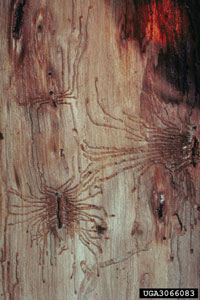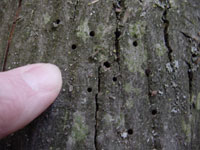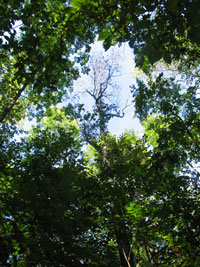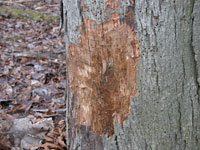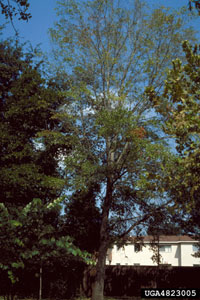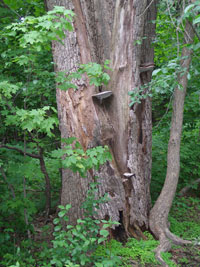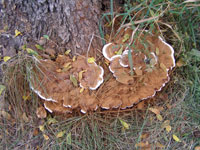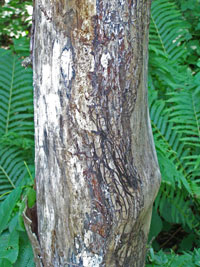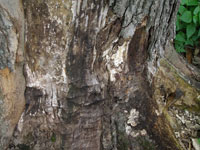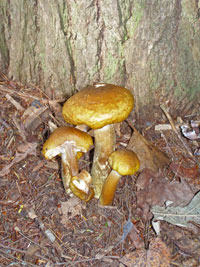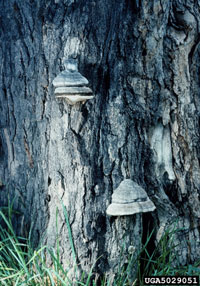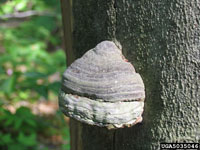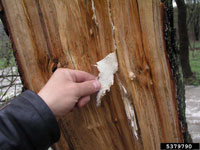Extension > Garden > Diagnose a problem > What's wrong with my plant? > Deciduous Trees > Hickory > Canopy is thin with yellow or brown leaves
Hickory > Leaves > Canopy is thin with yellow or brown leaves
1 of 5
Hickory bark beetles
Scolytus quadrispinosus
- Small, 1/8th inch, round exit holes in trunk and branches
- Heavily infested trees typically have sparse, yellowed leaves
- Premature leaf drop and broken twigs in crown can also occur when heavily infested
- Weakened, stressed trees most likely attacked, rarely infest healthy trees
- High Hickory bark beetle populations are often associated with Hickory decline
- Adults dark brown to black, less than ¼ inch long
- More information on Hickory bark beetles
2 of 5
Hickory decline
Ceratocystis smalleyi and
Scolytus quadrispinosus
- Leaves are wilted or undersized, thin canopy with dead branches
- When bark is peeled back, numerous reddish brown oval cankers up to 1 ft. long can be seen
- Bark surface often shows no symptoms, occasionally cracking or dark sunken area can be seen
- Dark bleeding spots that appear in May or June indicate cankers below the bark
- Groups of young green shoots (sprouts) often form along the trunk; these wilt and die within a year
- Round 1/8th inch exit holes of hickory bark beetles on upper trunk
- Larval galleries often visible in discolored sapwood
- Trees can decline and die in as little as two years when beetle populations are high
- More information on Hickory decline
3 of 5
Ganoderma root and butt rot
Ganoderma spp.
- Leaves are small and may yellow and drop
- Canopy appears thin with few leaves and multiple dead branches
- Fungal conks, semicircle shelf fungi, can be found from the base of the tree up to 3 feet high on the trunk
- Conks are reddish brown and shiny on top, white and porous underneath, a rim of white may be visible on the edge of the growing conks
- Infected wood at the base of the tree is white, soft, stringy or spongy
- Infected trees frequently break or fall over in storms
- More information on Ganoderma root and butt rot
4 of 5
Armillaria root rot
Armillaria spp.
- Infected trees have poor growth, dead branches in the upper canopy, undersized and/or yellow leaves
- Flat white sheets of fungal growth (mycelial fans) between the bark and sapwood at the base of infected trees
- Thick black, shoestring-like fungus can sometimes be seen under the bark, around roots and in the soil around the base of the tree
- Wood is decayed, white, soft and spongy; this may extend from the base of the tree well up into the trunk
- Trees frequently break or fall over in storms
- Clusters of honey-colored mushrooms may grow at the base of the tree in fall
- More information on Armillaria root rot
5 of 5
Heart rot
Fomes fomentarius
- Canopy may show no symptoms, or may have small, yellowing leaves or dead branches depending on the extent of decay
- In cross section, the wood at the center of the trunk is white, mottled, soft and crumbly
- Hoof-shaped, silvery-grey to brown, fungal fruiting bodies up to 8 inches across arise along the stem; often near a pruning wound, crack or other wound
- More information on heart rot




